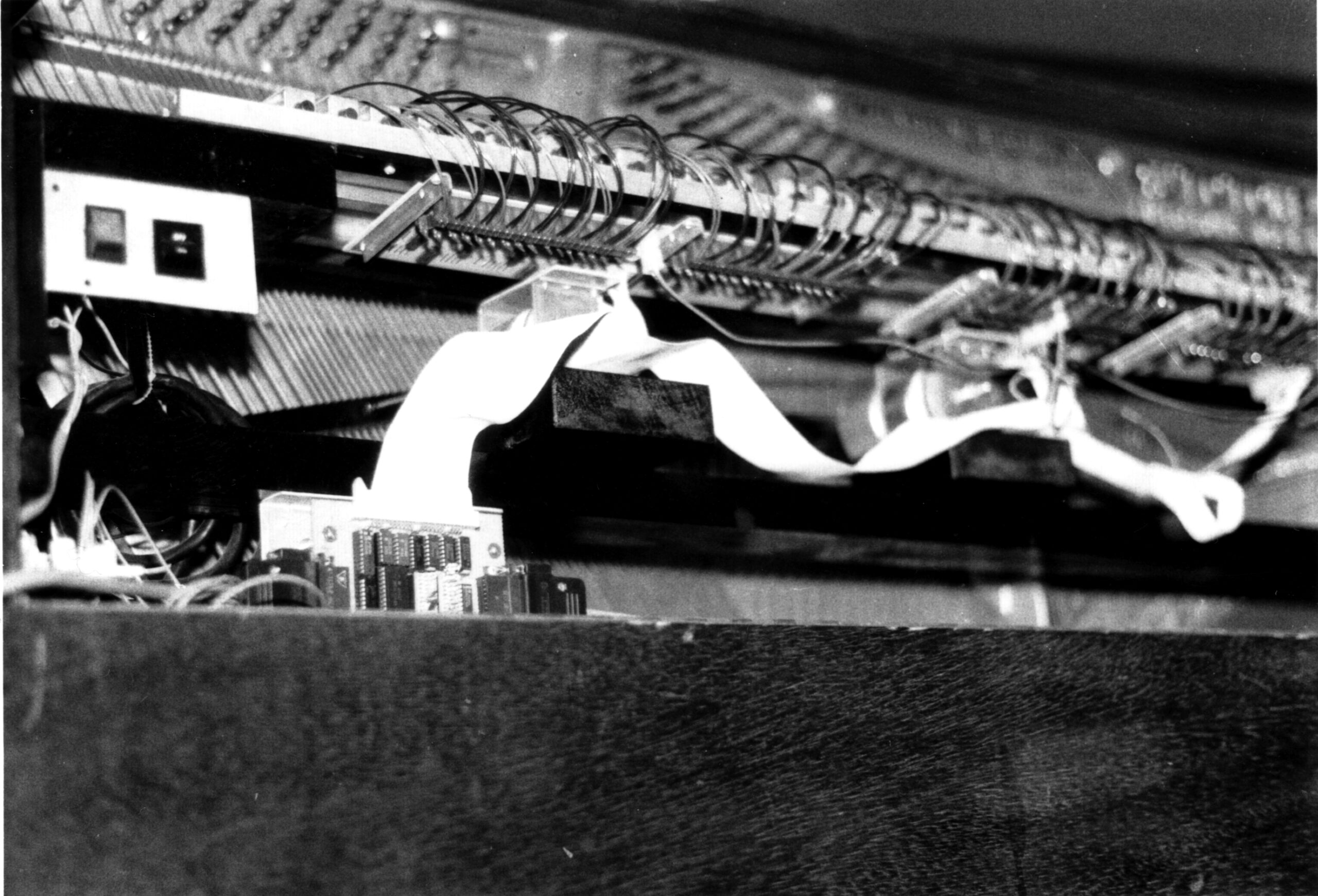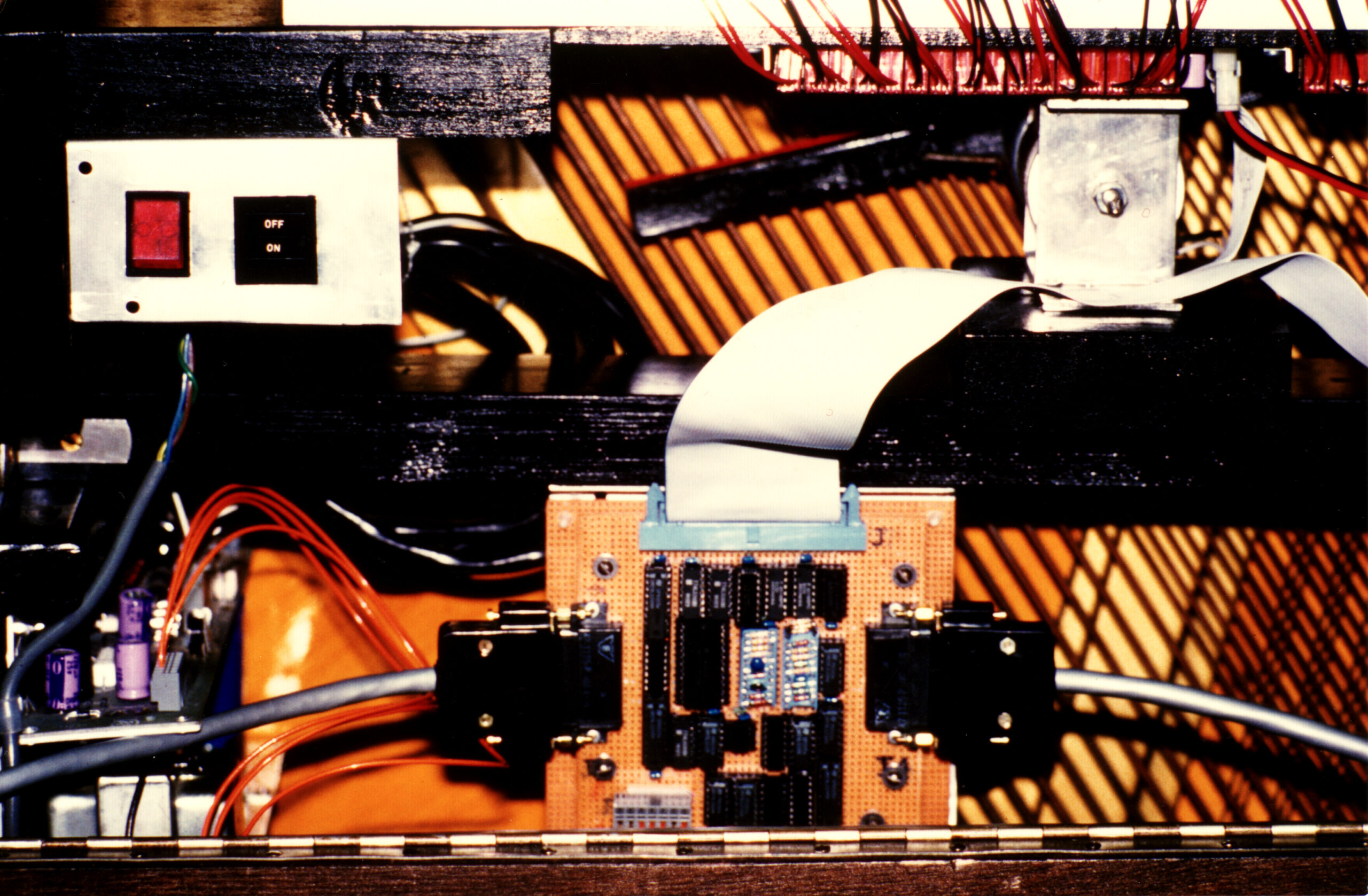Computer Controlled Pianos
The Early System (1982-1987)





Below is the page for the Computer Controlled Piano CD taken from my original website in 1998.
I had acquired a CD burner through an Australia Council grant in 1997, and started making CDs myself.
Any links referenced below shouldn’t go anywhere now.
The original recordings are on SoundCloud at https://soundcloud.com/alistair-riddell-676039960
Computer Controlled Piano Instruments (1982-87)
Acoustic Music from Electronic Forces
Australia Only – A$15.00 (postage included)
Overseas – US$15.00 (postage included)
send email to:
- One1A (1982)
0:38 - Two1A (1982)
2:18 - Existential Constellation (1982)
1:08 - Atlantic Fears (1983)
13:14 - Fantasie (1984)
3:51 - Variations for 2 Instruments (1984)
8:48 - Tales from Transitions (1986)
22:50 - Black Moon Assails (1987)
10:26 63:22
Views of the Modified Instrument (circa 1985)
See images above.
Introduction
Sturm and Drang (storm and stress) was the name given to a literary movement in Germany in the 1760’s and later came to “denote a period of youthful exuberance and/or maladjustment”. Some aspects of this movement resonated with me as I was thinking about this CD and when I uttered the phrase, I was reminded as much of the physical nature of project as its musical outcome. So the title stuck.
Technical Preamble
These works, with the exception the last Black Moon Assails, were produced on 8 bit microcomputers. The first three pieces were produce on a friend’s S100 8 bit system. I knew very little about computers in 1982 but was about to learn probably more than was really necessary.
The data for these 3 works was entered into and stored on the computer through a debugging tool called DDT Dynamic Debugging Tool from CPM.
This data was viewed as a series of “frames” that would transmitted at constant rate of 32/second to the instrument. All information had to be present in these frames to make the performance run smoothly. This initial interface approach was simple but very slow.
1983 was a significant year for development of the piano project for a number of reasons. I received an award which allowed me to buy a computer. It was a single board micro with 128k of memory and two 8 inch floppy disks. Each capable of storing 1 Meg. Wow! New interface hardware was built which transcended all the limitations inherent in the previous approach. Data could be sent quickly and efficiently to more than one instrument and up to 4 instruments could be connected simultaneously. Around the end of 1983 I built a prototype modified piano on which I composed Atlantic Fears. In early 1984, a better modified instrument was built which was used in the recording and also went on tour to the Adelaide Festival that year.
Conlon Nancarrow (1914-97)
Well, you are probably wondering by now what influence, if any, Colon Nancarrow’s music had on my work. When you listen to this CD you will have a better understanding but to give you some idea let me say that it was not what you might expect. For one thing, I was not interested in an expansion of the formal parameters of music, that is, tempo, harmony, rhythm, etc. Certainly not tempo. I think it was more the resulting sound that captivated me. The most influential work of Nancarrow’s, for me, was and remains Study #25. This work is, I think, remarkable because it is as unique as any of his works get among themselves. Here the work alludes to a later kind of sound; something closer to an electronic aesthetic. For me it was a starting point to explore computer/machine interaction at a time when it was still very new.
I had the privilege of staying with Nancarrow and his family in Mexico City and Cuernavaca in April of 1987 and heard a few of my favourite pieces performed in his studio. Ironically, when I met him, I didn’t realize that I had probably written my last work for computer controlled instruments.
Notes on the Tracks
One1A (1982)
This was the first of my own compositions. Earlier, I had produced a version of Bach’s Invention No. 4 and a very racy version of Ligeti’s Continuum for Harpsichord (Actually there are 2 versions of this work. One from 1982 and another from 1985.)In scoring this work, I used a matrix notation scheme showing where the notes would go according to the data structures I had to work with.
What I probably didn’t realize at the time was how the mode of producing and performing the work inclined me towards a compressed compositional style. It was easy to run out of memory and together with the difficulty of entering the data, led to the work being unusually intense.
Track list
Two1A (1982)
This is the second work and more ambitious in its compositional scheme than One1a. Same technical approach. I like this piece because it hints at a kind of extreme aesthetic that was just waiting to break out.Track list
Existential Constellation (1982)
This is the third and final work from the early period. I began to experiment with note structures that I could manipulate on the computer more easily. This led to a more abstract sound because of the ability to shift patterns around in the data file.
Later I would appreciate that one could write programs to generate data. An interesting proposition after labouring over text/score editors.
Track list
Atlantic Fears (1983)
This work was composed in late 1983 on a prototype instrument that I crudely constructed from an old upright piano. I can’t remember how long I took to compose but it wasn’t long just tedious. What was difficult about the compositional process was experimenting with the instrument without using the computer. The instrument was very primitive (as you can see by the photographs) with only one moving part, the hammer, which was activated by the computer and returned by spring. Not that efficient but simple. In order to hear what sounds were possible, I flicked the solenoids and listened as they hit the strings. Very crude performance technique considering the density of the final piece. There were no individual dampers on each hammer so the instrument could become very resonant very quickly. 2 large damper bars could be lowered onto the lower 2 ranks of strings to quell some of the sound but it was still resonant.
I also used a different scoring system developed by my brother-in-law, Chris Vaughan. Chris wrote a Basic program which interpreted a score format which could be assembled in a text editor. This allowed me to think on a more abstract and detailed compositional level. It also complimented the new interface hardware built by Harry Tagaris which at this pre-MIDI stage it was very sophisticated for the time. There were two wire-wrapped interface cards which could be “daisy chained” allowing the instruments and the computer to be conveniently positioned in relation to each other. Even after MIDI appeared it was still physically a faster communications system.
Track list
Fantasie (1984)
Fantasie was scored using two formats. For the first movement, I used a simple matrix scheme for time/pitch.The squares could be coloured to reflect dynamic differences. In the final section, I used standard notation. This proved to be difficult to translate but gave me a better idea of the kind of music I wanted to hear.
It’s a fun kind of piece. It begins with an almost cliched kind of mechanical presentation which is eventually swamped as the voices accrue, closing with 8 parts, oscillating in octaves. The instrument tened to gently sway at this point. The final part sweeps away the idea of mechanical music as the intensity dissipates.
Track list
Variations for 2 Instruments (1984)
Well, it ultimately had to happen. Two instruments at once. This was an awkward piece to compose for simply because of the instrumental configuration. Fortunately, I had both instruments in the one place at the time and was able to move the computer around often enough to get an idea of how the piece was developing.The modified instrument was used with the damper bars down occasionally. This created a kind of pitched drumming sound that I would have liked to have explored in more detail in another work. But alas…
Another interesting effect that I discovered was that I could delay data to one instrument by a certain duration which resulted in a kind of echo effect. However, it also meant that the piece slowed down in tempo. One of the side effects of using a slow 8 bit machine.
Track list
Tales from Transitions (1986)
This tale is one of a number that I recorded as they were algorithmic composition. I wrote a program in Pascal which played the instruments from a set of data which was manipulated in real-time. Algorithmic composition becomes very attractive when you realize that both the composition and the performance can become part of the fun of writing a program. That’s assume that one likes writing programs.
I was to later spend a lot of time programming script languages to process audio signals (see CD “42” for a collection of works in this genre and my PhD dissertation, chapter 4.)
Track list
Black Moon Assails (1987)
This work is the last and most extreme work I was to produce for the modified instrument and in fact, it was all performed on the lowest two octaves of the instrument. In 1988 I cannibalized both mechanisms in order to build the Meta-Action which to date has not been explored to it’s full potential.
Black Moon Assails was a radical departure from the other works for a number of reasons. Perhaps this was stimulated by the fact that I used a new computer called an Amiga which I bought in 1986. This computer was the way of the future in 1986 being more powerful and user friendly than my previous 8 bit micro.
The work is also a live improvisation where I played the computer keyboard to make the sounds. From computer only performance, I had progressed to performer machine interaction and it was certainly one of the strangest compositions to come from that kind of collaboration in 1987.
The mechanical details and performance technique are extensively discussed in my MA thesis which you can access right here.
Track list
The Meta-Action (A Later Computer Controlled Piano System)
Biography
42
Articles and Publications
Compositions
Home Page